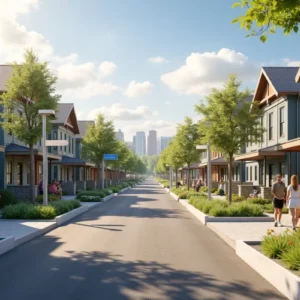The growing population in urban areas has necessitated the demand for innovative and efficient housing solutions. In recent years, House in Multiple Occupations (HMOs) has emerged as a prominent trend, offering a viable solution to the urban housing crisis.
This article explores the reasons behind the increasing popularity of HMOs in urban areas, their benefits and drawbacks, and their potential as a long-term housing solution. As urban landscapes evolve, understanding the rise of HMOs becomes essential in addressing the complex challenges of housing shortages and affordability in densely populated cities.
The Benefits of HMOs in Urban Areas
The benefits of HMOs in urban areas are manifold. Firstly, they provide an affordable housing option for individuals in urban areas where housing costs are typically higher. The shared nature of HMOs allows for lower individual rental costs, making them particularly attractive to young professionals, students, and low-income individuals. Additionally, HMOs often offer flexible rental terms, allowing tenants to avoid long-term commitments and easily adapt to changing circumstances or career opportunities.
HMOs promote social connectivity and community building within densely populated urban areas. HMOs’ shared living spaces and common areas foster interaction and collaboration among tenants, creating a sense of belonging and support. This can be especially beneficial for newcomers to urban areas or individuals seeking a greater sense of community. HMOs also often provide additional amenities such as shared kitchens, laundry facilities, or communal gardens, enhancing residents’ overall quality of life.
HMOs offer several key benefits in urban areas, including affordability, flexibility, and community-building opportunities. As cities continue to face housing shortages and affordability challenges, the rise of HMO investment provides a practical and sustainable housing solution that caters to the needs of urban residents. However, it is important to address the potential drawbacks and ensure regulation and oversight to guarantee the well-being of tenants and maintain the integrity of HMOs as a housing option.
Challenges and Drawbacks of HMOs in Urban Housing
HMOs in urban housing present a range of challenges and drawbacks. Firstly, the potential loss of community cohesion is a significant concern. As HMOs often involve converting existing family homes into multiple separate units, the character and atmosphere of traditional neighbourhoods can be altered. This can lead to a breakdown in social connections and a sense of displacement for long-term residents.
Another challenge is the potential for insufficient regulation and oversight. HMOs may attract shameless landlords who prioritise profit over the well-being of their tenants. Inadequate maintenance and lack of health and safety standards enforcement can result in substandard living conditions. Additionally, the high turnover of tenants in HMOs can disrupt the stability of neighbourhoods and create a transitory population with limited investment in the local community.
While HMOs offer a solution to housing shortages in urban areas, they can also face significant challenges. Policymakers and urban planners must balance providing affordable housing options and ensuring adequate regulations and oversight to overcome the drawbacks of this housing model.
The Future of HMOs as a Sustainable Housing Solution
As the demand for housing solutions in urban areas grows, House in Multiple Occupation (HMOs) are becoming an increasingly popular choice. HMOs offer an innovative and efficient solution to the urban housing crisis, particularly in densely populated cities. Their rise can be attributed to the increasing need for affordable, flexible housing options.
One of the main benefits of HMOs is their ability to provide affordable accommodation for individuals, families, and students who may not be able to afford a traditional home on their own. By renting out individual rooms within a larger property, HMOs can reduce living costs and promote a sense of community among tenants. Additionally, HMOs allow for better land use in urban areas, using existing properties and reducing the need for new construction.
However, there are also drawbacks to consider when it comes to HMOs. They often face regulatory challenges and concerns over the impact on neighbourhood dynamics. Noise, overcrowding, and parking issues can arise if not properly managed.
The future of HMOs as a sustainable housing solution lies in finding the right balance between affordability, regulation, and community integration. By addressing these challenges and maximising the benefits, HMOs have the potential to play a significant role in long-term urban housing solutions.





